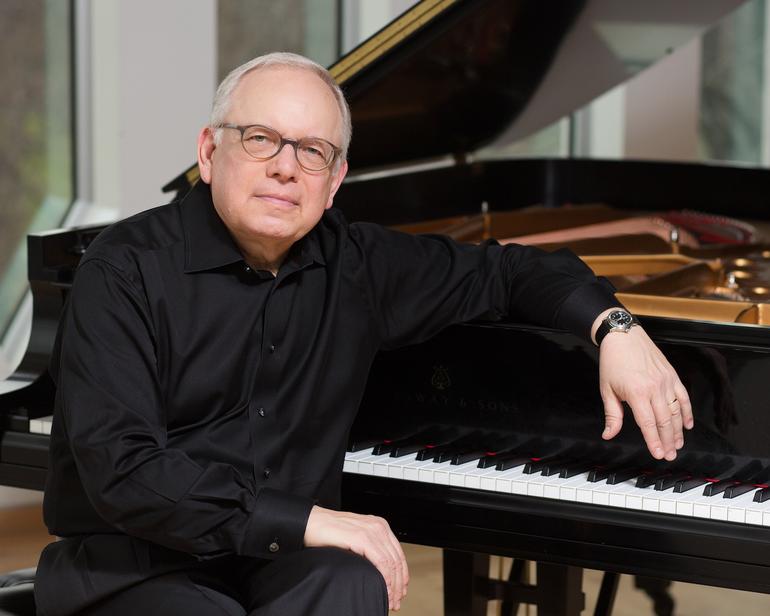Amid uneven moments, pianist Takács offers fluent, thoughtful Beethoven

Peter Takács performed a Beethoven program in the Key Pianists series Sunday afternoon at Weil Hall.
Key Pianists is a new concert series that will, in the words of founder, pianist Terry Eder, “fill a void in New York concert life” by presenting “seasoned pianists” who have honed their musicianship with a focus on repertoire they find personally important.
This is a welcome idea. The world is full of terrific, insightful musician who have neither the fame nor the good fortune to sustain the kind of touring career that brings musicians here for recitals and concertos.
The series debuted Sunday afternoon at Weill Recital Hall, with a concert from pianist Peter Takács. Takács so well fills the series description that it might have been purposefully tailored around him. He has taught at Oberlin since 1976, and is a distinguished Beethoven interpreter with a critically acclaimed recording of the complete piano sonatas to his credit (released on the Cambria label in 2011).
In a series within the series, Takács was opening a set of three concerts titled “The Beethoven Experience.” Sunday was a survey of early works, and the remaining two concerts will look at the composer’s middle and late periods, in November and January, respectively.
Early Beethoven meant music from the 18th century; two of the Opus 2 piano sonatas, the Opus 11 Trio for clarinet, cello, and piano, and the “Pathetique” Sonata, No. 8, from 1798. The chamber piece was a feature of the series—there will be one piece every concert where Takács plays within an ensemble—and the notable pair of clarinetist Boris Allakhverdyan and cellist Carter Brey were on hand Sunday.
Takács began with Sonata No. 1, Op. 2, No. 1, and his virtues were immediately apparent. He is a thoughtful musician, not so much deeply cerebral as with interesting things to say about how the music should sound. In the Allegro movement, that meant a subtle legato while playing the highly percussive initial themes, and an equally judicious, and expressively effective seasoning of rubato to round off selected phrases.
The only real flaw in the sonata performance, and throughout the concert in general, is that in stretches where Takács’ thinking was indecisive or ambiguous, the music turned opaque, or his execution stumbled. In the first sonata, the sequence in the Allegro sounded confused each time around—it was unclear if Takács felt the bass line or the chord sequence was the most salient feature of the passage.
But the rest of the sonata was exemplary. Takács’ touch was fluid and supremely elegant in the Adagio movement, and his sense of dynamics, form, and rhythm was strong in the final two movements.
He was a sensitive and agile ensemble member in the Trio, which followed. This is some of Beethoven’s most congenial social music, and it was a pleasure to hear the musicians’ own, clear pleasure in playing together. Allakhverdyan had a sweet, mellow tone, and Brey is a superb chamber musician, with a uniquely flexible sound.
One is accustomed to the profundity of Beethoven, but the trio is lighthearted. Until the fantastic coda, that is, which not only builds unexpected harmonic tension but introduces the composer’s specialty, using accents and shifting rhythms to kick the pulse around, even as the tempo remains the same. This is the fundamental way that Beethoven creates explosive power, and Takács lead the music brilliantly, playing perfect rhythms in unerring tempo, while producing an enormous combination of disorientation and excitement with the slightest changes in accents.
The concert’s second half opened with the “Pathetique,” the sound of Beethoven on the verge of opening the door to the romantic era. Takács held his patience and his pace in the first movement, and built a satisfying sense of harmonic and dramatic tension without manner or exaggeration. It was in the music that followed that the recital retreated by a small but noticeable degree from the high level of the first half.
The Adagio cantabile of the “Pathetique” was fluid and lyrical, but faceless—Takács had the music speak well for itself, but by this point in the concert he had already created the expectation of clear, prominent and fresh thinking about Beethoven. Takács’ drive in the Rondo also shaded a lack of particular meaning—not generally a critical problem, except when the musician has already shown what he can do by thinking through his playing.
The concluding Sonata Op. 2, No. 3 was the most variable performance of the day. In the first movement, the pianist was once again full of ideas about the musical, intellectual and emotional meaning of the contrasting phrases, but there were enough technical problems—awkward gaps and hesitations—that their articulation was at times muddled and scattered.
Takács recovered the rest of the way. The Adagio was dignified and lovely, and the dialogue between left and right hands in the Scherzo had a spontaneous feeling, like the notated improvisation that is at the root of the music. In the final movement, Takács once again used subtle modulations of tempo to excellent musical effect.
Peter Takács’ Beethoven series continues November 12 and January 14. Key Pianists Concert Series.






